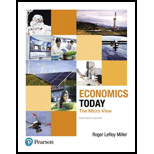
To raise funds aimed at providing more support for public schools, a state government has just imposed a unit excise tax equal to $4 for each monthly unit of wireless phone services sold by each company operating in the state. The following diagram depicts the positions of the demand and supply curves for wireless phone services before the unit excise tax was imposed. Use this diagram to determine the position of the new market supply curve now that the tax hike has gone into effect.
- Does imposing the $4 per-month unit excise tax cause the market
price of wireless phone services to rise by $4 per month? Why or why not? - What position of the $4 per - month unit excise tax is paid by consumers? What position is paid by providers of wireless phone services?

Concept introduction:
Market supply curve: A curve which gives the positive relationship between products supplied in the market and its price is called as market supply curve. It is an upward curve. There is a direct relationship between the price of the product and its supply. Hence, when the price of the product increases, its supply will also increase.
Excise tax: A tax paid while purchasing a good or a product is called the excise tax. Mostly this tax is included in the cost of the product.
Want to see the full answer?
Check out a sample textbook solution
Chapter 6 Solutions
Economics Today: The Micro View (19th Edition) (Pearson Series in Economics)
- Find the equation of the price offer curve and demand curve for the following utility function: U= min (3x, 2y). Let income of the consumer be M, price of good X is Px and price of good Y be Py. Also draw both the curves. (b) Let utility function of a consumer be given by U(x,y) = xy + x, where X and Y are the two goods (i) Is marginal rate of substitution diminishing? (ii) Are marginal utilities of both goods X and Y diminishingarrow_forwardx, y) = 2√x + y. Let price of X be $0.50, price of Y be $1 and income is $10. (i) Find initial equilibrium of the consumer. (ii) Find the new equilibrium if price of X falls to $0.20. (iii) Using Hicksian technique decompose the price effect into substitution and income effectsarrow_forwardPrice elasticity by the hour of day. Average parking occupancy rates of 2011 (i.e., after the rate change) in neighborhoods with a decrease, no change and an increase in rates are also displayed in this figure. 0.0 -0.1 E I -0.2 a S -0.3 t i -0.4 C i -0.5 t Y -0.6 -0.7 -0.8 Hour of the day 60 8 9 10 11 12 13 14 15 16 17 -0.9 -Decrease price elasticities model 1 → Decrease neighborhoods' occupancy in 2011 ...... No price change neighborhoods' occupancy in 2011 Increase price elasticities model 1 ⚫ Increase neighborhoods' occupancy in 2011 50 8333PONG> 40 40 30 20 20 a n C Y 30 10 0 (0°) ૪ Based on the figure showing estimated elasticities after the price increase, what times of day have the most elastic parking demand? Why do you think this is the case? Explain.arrow_forward
- Financial analysis 2022, 2023, and 2024 for O' Reilly's trends in dataarrow_forward9-5. In a replacement analysis for a vacuum seal on a spacecraft, the following data are known about the challenger: the initial investment is $12,000; there is no annual maintenance cost for the first three years, however, it will be $2,000 in each of years four and five, and then $4,500 in the sixth year and increasing by $2,500 each year thereafter. The salvage value is $0 at all times, and MARR is 10% per year. What is the economic life of this challenger? (9.5)arrow_forward9-4. A vehicle costs $30,000 and incurs maintenance costs. increasing by $500 annually, starting at $1,000 in year one. When is it economical to replace it, assuming no salvage value? Use a MARR = 8% per year.arrow_forward
- 9-14. Analyze the replacement of an old crane with $7,000 annual maintenance and a $30,000 current market value with a new one for $100,000 and $2,000 annual maintenance. The MARR is 15% per year.arrow_forward9-15. A small high-speed commercial centrifuge has the following net cash flows and abandonment values over its useful life (Table P9-15, p. 454). The firm's MARR is 12% per year. Determine the optimal time for the centrifuge to be abandoned if its current MV is $9,500 and it won't be used for more than five years. (9.8)arrow_forwardBalance sheet, income statement and statement of cash flow 2022, 2023, and 2024 for AutoZone and trend analysisarrow_forward
- 9-1. An existing machine with a book value of $10,000 has maintenance costs of $2,000 per year. A new machine costs $25,000 with annual maintenance costs of $500. When should the existing machine be replaced? The company's MARR is 15% per year.arrow_forward9-3. Analyze replacing a commercial oven with $800 annual maintenance and a $3,000 salvage value with a new one for $15,000 and $300 annual maintenance. The company's MARR is 12% per year.arrow_forward6. If D(p) = 100/p and c(y) = y2, what is the optimal level of output of the monopolist?arrow_forward

 Principles of Economics (12th Edition)EconomicsISBN:9780134078779Author:Karl E. Case, Ray C. Fair, Sharon E. OsterPublisher:PEARSON
Principles of Economics (12th Edition)EconomicsISBN:9780134078779Author:Karl E. Case, Ray C. Fair, Sharon E. OsterPublisher:PEARSON Engineering Economy (17th Edition)EconomicsISBN:9780134870069Author:William G. Sullivan, Elin M. Wicks, C. Patrick KoellingPublisher:PEARSON
Engineering Economy (17th Edition)EconomicsISBN:9780134870069Author:William G. Sullivan, Elin M. Wicks, C. Patrick KoellingPublisher:PEARSON Principles of Economics (MindTap Course List)EconomicsISBN:9781305585126Author:N. Gregory MankiwPublisher:Cengage Learning
Principles of Economics (MindTap Course List)EconomicsISBN:9781305585126Author:N. Gregory MankiwPublisher:Cengage Learning Managerial Economics: A Problem Solving ApproachEconomicsISBN:9781337106665Author:Luke M. Froeb, Brian T. McCann, Michael R. Ward, Mike ShorPublisher:Cengage Learning
Managerial Economics: A Problem Solving ApproachEconomicsISBN:9781337106665Author:Luke M. Froeb, Brian T. McCann, Michael R. Ward, Mike ShorPublisher:Cengage Learning Managerial Economics & Business Strategy (Mcgraw-...EconomicsISBN:9781259290619Author:Michael Baye, Jeff PrincePublisher:McGraw-Hill Education
Managerial Economics & Business Strategy (Mcgraw-...EconomicsISBN:9781259290619Author:Michael Baye, Jeff PrincePublisher:McGraw-Hill Education





